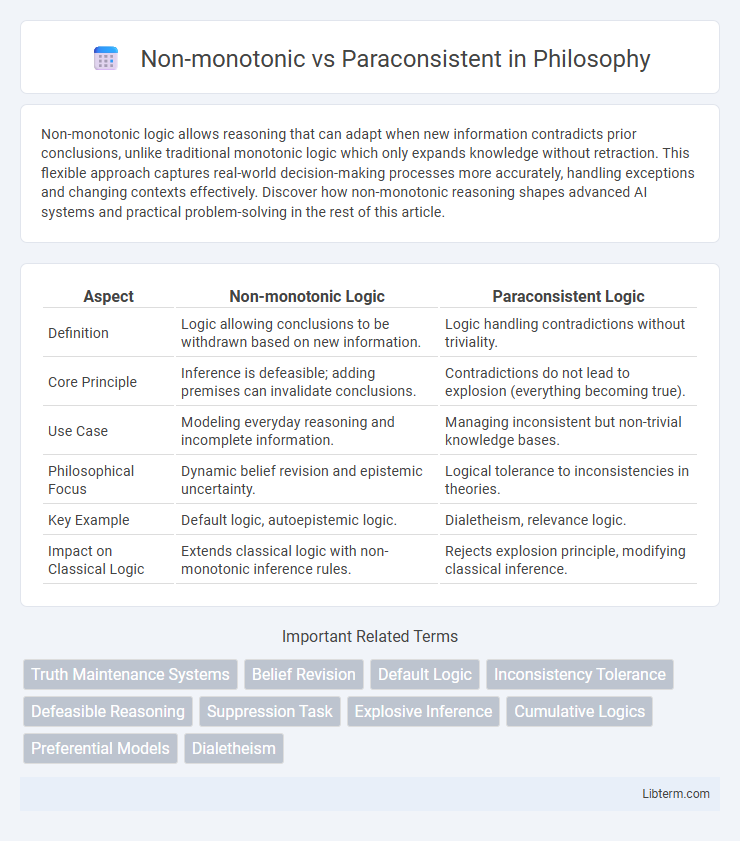Non-monotonic logic allows reasoning that can adapt when new information contradicts prior conclusions, unlike traditional monotonic logic which only expands knowledge without retraction. This flexible approach captures real-world decision-making processes more accurately, handling exceptions and changing contexts effectively. Discover how non-monotonic reasoning shapes advanced AI systems and practical problem-solving in the rest of this article.
Table of Comparison
| Aspect | Non-monotonic Logic | Paraconsistent Logic |
|---|---|---|
| Definition | Logic allowing conclusions to be withdrawn based on new information. | Logic handling contradictions without triviality. |
| Core Principle | Inference is defeasible; adding premises can invalidate conclusions. | Contradictions do not lead to explosion (everything becoming true). |
| Use Case | Modeling everyday reasoning and incomplete information. | Managing inconsistent but non-trivial knowledge bases. |
| Philosophical Focus | Dynamic belief revision and epistemic uncertainty. | Logical tolerance to inconsistencies in theories. |
| Key Example | Default logic, autoepistemic logic. | Dialetheism, relevance logic. |
| Impact on Classical Logic | Extends classical logic with non-monotonic inference rules. | Rejects explosion principle, modifying classical inference. |
Introduction to Non-Monotonic and Paraconsistent Logics
Non-monotonic logic allows reasoning systems to withdraw conclusions in light of new information, contrasting with classical logic's fixed inference patterns. Paraconsistent logic handles contradictions by permitting conflicting information without degenerating into triviality, enabling robust reasoning in inconsistent datasets. Both frameworks support advanced knowledge representation, where dynamic or contradictory data challenges traditional monotonic inference methods.
Defining Non-Monotonic Reasoning
Non-monotonic reasoning allows conclusions to be withdrawn in light of new evidence, reflecting the dynamic and uncertain nature of real-world information. It contrasts with monotonic logic, where conclusions once drawn remain valid regardless of additional data. This flexibility differentiates non-monotonic reasoning from paraconsistent logic, which primarily addresses contradictions without retracting prior inferences.
Understanding Paraconsistent Logic
Paraconsistent logic enables reasoning in the presence of contradictions without collapsing into triviality, distinguishing it from classical logic systems where any contradiction renders the system unusable. Unlike non-monotonic logic, which allows conclusions to be withdrawn based on new information, paraconsistent logic tolerates inconsistencies and manages them through specialized inference rules. This approach is crucial in fields like artificial intelligence and knowledge representation, where conflicting data must be processed without invalidating the entire reasoning framework.
Key Differences Between Non-Monotonic and Paraconsistent Systems
Non-monotonic systems allow the introduction of new information to retract previous conclusions, reflecting reasoning under uncertainty and incomplete knowledge. Paraconsistent systems tolerate contradictions without collapsing into triviality, enabling reasoning in the presence of inconsistent but non-trivial information. The key difference lies in non-monotonic logic adapting to evolving knowledge by modifying inferences, whereas paraconsistent logic maintains reasoning consistency despite contradictory data.
Common Applications of Non-Monotonic Logic
Non-monotonic logic is widely applied in artificial intelligence for reasoning under uncertainty, such as expert systems, automated planning, and default reasoning, where conclusions can be retracted with new information. Paraconsistent logic, in contrast, is primarily used to handle contradictory information without collapse, notably in knowledge bases and database systems with inconsistent data. Common applications of non-monotonic logic include intelligent agents adapting to dynamic environments, legal reasoning where exceptions frequently occur, and diagnostic systems that revise hypotheses when new evidence emerges.
Practical Uses of Paraconsistent Logic
Paraconsistent logic is widely applied in fields requiring robust reasoning under inconsistent information, such as knowledge representation, artificial intelligence, and legal reasoning. Unlike non-monotonic logic, which handles reasoning with default assumptions and changing information, paraconsistent logic allows systems to tolerate contradictions without descending into triviality, enabling practical use in database management and fault diagnosis. This logical framework supports decision-making processes where conflicting data coexists, ensuring reliable conclusions without discarding any part of the dataset.
Challenges in Non-Monotonic Reasoning
Non-monotonic reasoning faces challenges such as handling incomplete or evolving information, which complicates the ability to draw consistent conclusions as new data is introduced. Unlike paraconsistent logic that tolerates contradictions, non-monotonic systems must revise beliefs when conflicts arise, creating computational complexity and uncertainty in inference mechanisms. Addressing these challenges requires sophisticated algorithms capable of belief revision and managing default assumptions without collapsing into inconsistency.
Handling Inconsistencies with Paraconsistent Logic
Paraconsistent logic enables reasoning in the presence of contradictions without collapsing into triviality, unlike classical logic frameworks that typically fail when inconsistencies arise. This logic system tolerates conflicting information, making it highly effective for databases and knowledge bases where data may be incomplete or contradictory. Non-monotonic logic modifies conclusions based on new evidence but does not inherently address contradictory data as robustly as paraconsistent approaches.
Comparative Analysis: Non-Monotonic vs Paraconsistent Approaches
Non-monotonic reasoning allows the withdrawal of inferences when new information contradicts previous conclusions, effectively handling incomplete or evolving knowledge bases. Paraconsistent logic, in contrast, tolerates contradictions without collapsing into triviality, enabling reasoning in contexts with inconsistent but relevant information. While non-monotonic approaches prioritize dynamics in belief revision, paraconsistent methods emphasize stable reasoning in the presence of conflicting data, making their comparative analysis crucial for applications in knowledge representation and artificial intelligence.
Future Trends in Logic: Integration and Research Directions
Future trends in logic emphasize the integration of non-monotonic and paraconsistent reasoning to handle inconsistent and incomplete information in dynamic environments. Research focuses on developing unified frameworks that combine the adaptability of non-monotonic logic with the robustness of paraconsistent logic for real-world applications like AI and knowledge representation. Advances in hybrid systems and scalable algorithms are driving innovations toward more expressive and resilient logical models capable of managing uncertainty and contradictions simultaneously.
Non-monotonic Infographic

 libterm.com
libterm.com